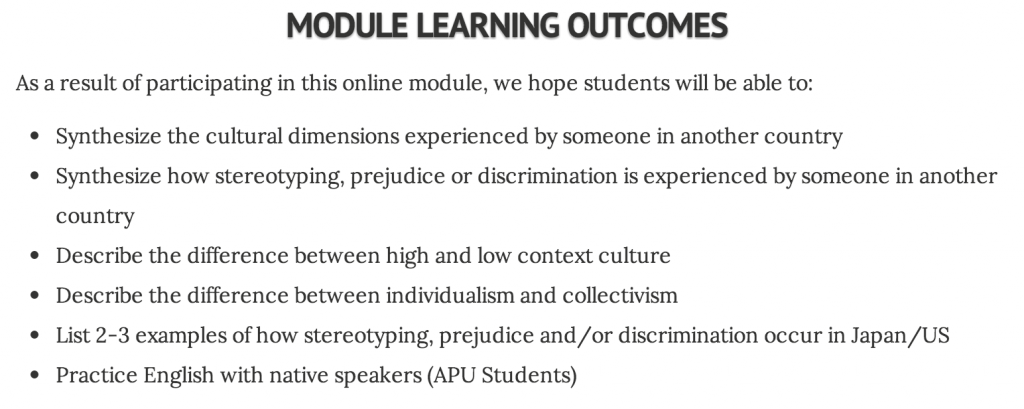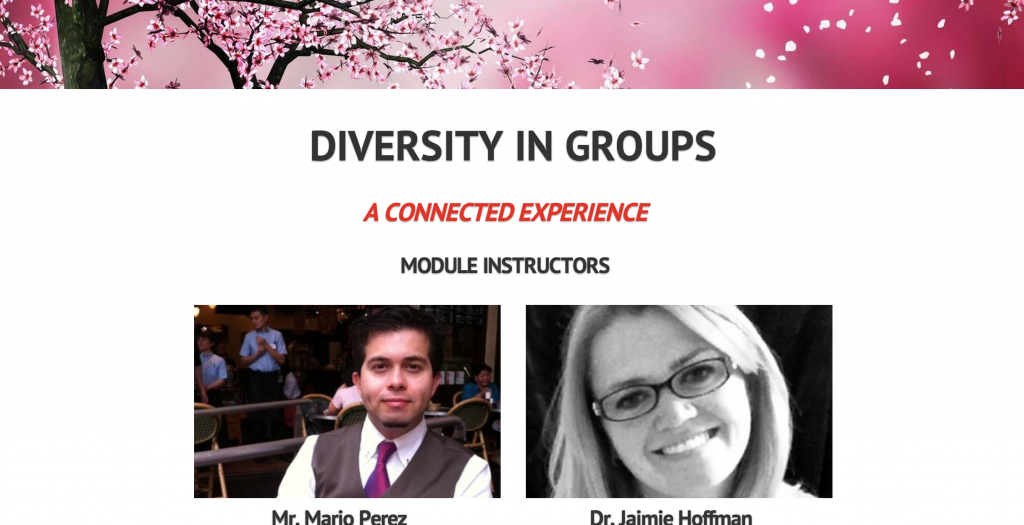Diversity in Groups: A Connected Experience
This is a guest post by educator and VoiceThreader, Dr. Jaimie Hoffman
The Idea
Last summer I was inspired to dream about what could be possible if I could connect my students with students in another country in a common learning experience using technology. This was an exciting possibility both because gaining international perspectives is a key pillar of my institution and because I think it is an important outcome of the undergraduate experience. I thought about collaborating with friend from high school, Mario Perez, who now teaches English in Japan; I thought he might be up for a challenge and ready to color outside of the box.
Getting Started
Mario quickly agreed to work with me on this adventure. First, we discussed and finalized what we wanted our students gain from this experience and established measurable outcomes. We then decided that the module would involve students from my Group Communication Course working with students from his Intermediate English Course to learn about diversity, specifically Hofstede’s Cultural Dimensions, together and…. teach each other along the way. An additional outcome for Mario’s students was to get practice speaking and listening to English.

With the outcomes finalized, we looked at what digital tool might best meet our needs. How the heck can we get students living 5400 miles apart and 17 hours time difference to work together? Sure, we could have used a static, text-based discussion forum, but we identified VoiceThread as the best option for creating a humanized experience.
The Module
We created the module itself including, instructor information, context, outcomes, instructions, VoiceThread links, and a reflection form, on a web page using Populr.me. We divided our students into twelve small groups with about five students from CI and three students from APU. It was important to us that all voices could be heard in the conversation and with over eighty students, it would be counteractive to have large class discussions.

The process of putting together the module was fairly smooth although we encountered differences between educational and cultural practices in the US and Japan that had some implications on our module. For instance, something as small as how we refer to our students in our videos (e.g. Japanese students, US students) became a focal point of our conversations because we realized that we did not want to offend students who may not be Japanese but who live in Japan. While the same applied to the students in the US, tensions between Japan and Korea gave the issue greater prominence. In essence, Mario and I learned about diversity as we prepared this experience about diversity.
The VoiceThread consisted of a series of slides, which were a mixture of Mario and I narrating and posing discussion questions. The students were given three due dates: by the first date, they were to post their initial response to our questions and pose a question to their peers in the other country, by the second date they were to respond to their peers’ questions and by the third date they were to submit their responses to a reflection.
Impact/Student Perceptions
Students responded positively to the module:
**–**82% of APU students who responded to the reflection survey reported they agreed or strongly agreed with the fact that the module helped them practice English.
**–**89% of all students who responded to the survey indicated that they strongly agreed or agreed with the fact that it was exciting to work alongside students in another country.
The asynchronous nature of VoiceThread allowed students to reflect on their culture and the questions about another culture. One student said, “I had the chance to collect my thoughts on how I truly see my culture and having to explain why. It was nice to reflect.” The module introduced students to differences in ways that a textbook or class discussion probably could not achieve. This student’s reflection is a great example of this: “I learned that what is normal here can be very different in other countries. We are used to diversity here and experience a lot of different cultures, but in Japan the ethnicity of their people is pretty constant and unchanging. Another thing I learned is Japan has a lot of power distance in its culture.”
We plan to repeat this module again with slight modifications:
**–**Allow more time for planning: it took a lot of time collaborating to align outcomes, creating the presentation, securing student permissions, and explaining the module to students… and that’s just the work that took place before the module occurred.
**–**Add introductions and follow up to facilitate breaking the ice: we realized that our students could have benefitted from a few slides with “getting to know you” activities especially since the students in Japan began the module at a disadvantage with regard to their English language abilities.
**–**Provide opportunities for continued connections: many students told us they wished that their connections with students abroad could continue beyond the module. In the future, we plan to provide a facilitated post-module activity using VoiceThread to continue conversations.
**–**Structure more space between deadlines for enhanced engagement: The tight timeline and specific post requirements we used for participation may have stifled the conversation. Next time we plan to use less specifics on number and dates of post requirements and greater emphasis on the quality of conversation
**–**Recommend students to use microphones: Language was a definite challenge in this activity (which was also part of the learning process) for all involved; volume was an element of the process that could be controlled with use of microphones.
It was definitely a great learning experience for everyone involved and was invigorating to see how this can help us imagine possibilities for future connections.
Want to hear Mario and I talking about our experience with Michelle Pacansky-Brock? View our Hangout on Air on Wednesday, February 25, 2015 at 4:00 p.m. or check out the recording that will archived in the same location. We will also be presenting our experience at the upcoming ET4Online conference in Dallas, Texas.
Dr. Jaimie Hoffman is an Instructional Technologist and part-time faculty member at CSU Channel Islands. Jaimie has taught in blended, online and face-to-face format to undergraduate and graduate students. You can learn more about her at http://jaimiehoffman.com
